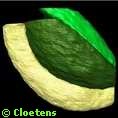Sunday, September 17, 2006
Researchers watch seeds in 3-D and discover an unknown air path

Researchers from the CNRS (Centre National de la Recherche Scientifique), the UJF (University J. Fourier) of Grenoble and the ESRF (European Synchrotron Radiation Facility) have recently visualised a plant seed in 3-D using synchrotron light. This new view has revealed that there is a network of voids between the cells which may be used for oxygen storage that is needed for efficient germination. It is the first time that a living organism is studied using the holo-tomography technique at a third generation synchrotron source. The team behind the discovery publishes its results in Proceedings of the National Academy of Sciences.
Embryonic photosynthesis leads to the production of seed-internal oxygen that is important for seed development and quality. In order to visualize seed-internal structures that could serve for oxygen storage conventional microscopic methods could not be used because they require the seed to be cut thus leading to air escape. By using holotomography at the ESRF, scientists could get the full picture of an arabidopsis seed without any structural modification.
--
Based on the PNAS Plant Biology paper "Quantitative phase tomography of Arabidopsis seeds reveals intercellular void network" (Abstract)
technorati tags: centre, national, recherche, scientifique, european, synchrotron, radiation, facility, grenoble, plant, seed, 3-d, light, network, voids, cells, germination, living, organism, holo, tomography, proceedings, national, academy, sciences, pnas, embryonic, photosynthesis, development, oxygen, arabidopsis, plant, biology, seeds
Add to: CiteUlike | Connotea | Del.icio.us | Digg | Furl | Newsvine | Reddit | Yahoo